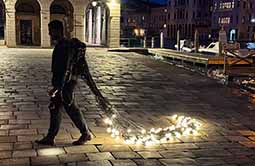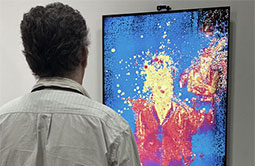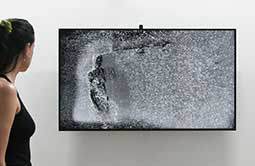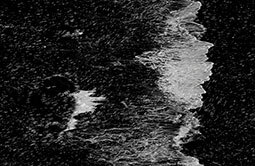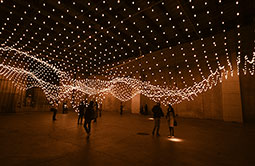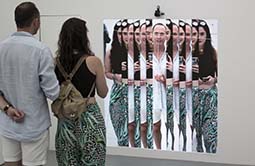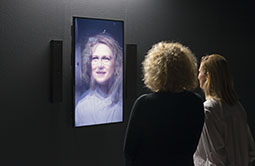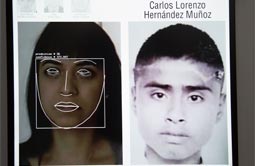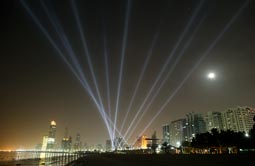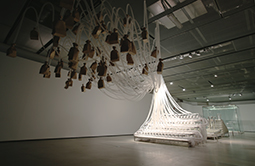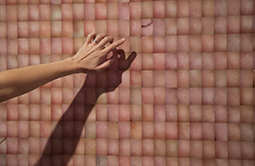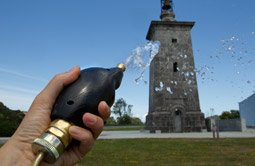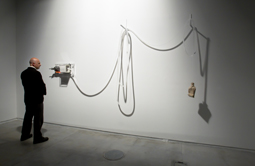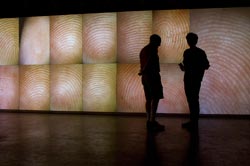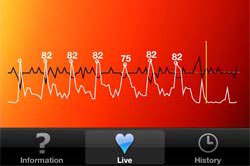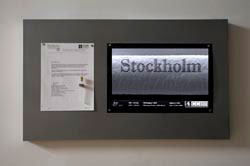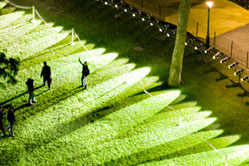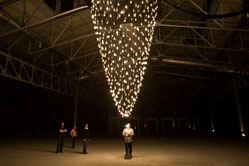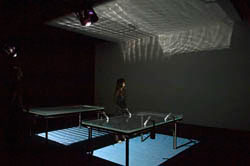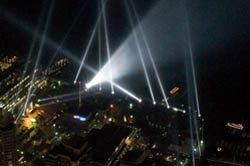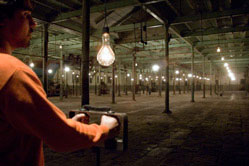Spectral Subjects
2024
“Spectral Subjects” is a thermal observatory that displays a constantly updating map of the room's temperature. Using thermographic cameras, the project detects heat and cold in the environment, including the building’s air circulation and ventilation, visitors’ body heat, and inanimate objects. As temperature is detected, the artwork creates a visible manifestation of the public’s “heat signature” in various ways, mixing live feeds with recently past heat signatures, materializing thermal echoes of the atmosphere, and creating an evolving portrait of uncanny spectral traces that make the atmosphere tangible. The artwork has two versions: a unique projection-based treatment that can be adapted to any architecture, and an edition that can be adapted to flatscreens of different sizes.
View details.
View details.
Pulse Voronoi
2024
One cubic metre of crystal explodes into 7,000 unique but complementary shards, expelled in all directions. "Pulse Voronoi" proposes a walk through the resulting cloud of crystals, shortly after the blast. The crystals are suspended in the room, each with a warm light that glimmers rhythmically to the recorded heartbeat of a different participant from the past. Five pulse sensors placed around the room detect visitors' heartbeats which can be heard in the room and seen in surrounding lights. Every new recording of vital signs deletes the oldest one, creating a memento mori.
View details.
View details.
Pulse Agglomerate
2024
"Pulse Agglomerate," a biometric performance, was presented during the 60th Venice Biennale. The piece consisted of a wearable armature that powered, controlled, and hauled hundreds of lightbulbs, each glimmering to the pulse of a different participant from the past. The performer wearing the piece walked around the streets of Venice, collecting one hundred heartbeats using an onboard pulse sensor.
View details.
View details.
Pulse Chandelier
2023
A “Pulse Chandelier” has three hundred Edison-shaped lights in polycarbonate or glass bulbs with 2700K LED filament inside. Each bulb softly glimmers to the heartbeat of a recording from the past. A photoplethysmography sensor is suspended and used as a light source beside the piece; when a hand is detected under this sensing light, the whole chandelier gradually pulses in sync with the participant’s heartbeat and records this new data, erasing the oldest recording in the array. The piece features a global dimmer so that the brightness can be easily controlled, and the piece can also be switched on and off with a standard light switch.
View details.
View details.
Thermal Drift
2022
“Thermal Drift” is an interactive artwork that visualizes the dispersion of body heat as emissions of thermal energy in the form of slow-moving packets or quanta that flow away from the participant. This artwork is available as both a projection and a standalone piece.
View details.
View details.
Thermal Poem
2022
A durational performance piece that consisted of a poem (by Leigh Kotsilidis) written on two naked bodies using ice-cold water. The writing was made visible by a live thermal camera projected onto the stage, and the words disappeared gradually as the bodies heated up the water.
View details.
View details.
Thermal Drift Density Map
2022
“Thermal Drift Density Map” is an interactive artwork that visualizes the dispersion of body heat as emissions of thermal energy in the form of slow-moving packets or quanta that flow away from the participant. This artwork is available as both a projection and a standalone piece.
View details.
View details.
Hormonium
Text Stream 8, 2022
“Hormonium” (Text Stream 8) is a generative artwork that presents sequences of ocean waves crashing and releasing airborne text particles, with the text representing acronyms of hormones that are released in accordance with human time-cycles. This artwork is available as both a projection and a standalone piece.
View details.
View details.
Pulse Topology
2021
“Pulse Topology” uses remote photoplethysmography (PPG) technology, developed to detect heartbeats without using touch. The biometric data collected from participants is used to illuminate 3,000 to 10,000 suspended light bulbs, creating an immersive audio-visual experience which forms a connective topography of the pulses of participants.
View details.
View details.
Remote Pulse
2019
“Remote Pulse” is an interactive installation consisting of two identical pulse-sensing stations that are interconnected over the internet. When a person places their hands on one station automatically the person on the other station feels their pulse, as the plates vibrate in sync with the heartbeat of the remote person, and vice versa. The piece was originally presented as part of Lozano-Hemmer’s “Border Tuner” installation across the US-Mexico border.
View details.
View details.
Bilateral Time Slicer
2016
“Bilateral Time Slicer” is a biometric tracking system that finds the axis of symmetry of members of the public and splits a live camera image into two slices. With each new participant time slices are recorded and pushed aside. When no one is viewing the work, the slices close and rejoin creating a procession of past recordings.
View details.
View details.
Redundant Assembly
2015
In "Redundant Assembly," an arrangement of several cameras composes a live-portrait of the visitor from six perspectives simultaneously, aligned using face detection. The resulting image is uncanny, detached from the laws of symmetry and the depth perception of binocular vision. If several visitors are standing in front of the work, a composite portrait of their different facial features develops in real time, creating a mongrel "selfie".
View details.
View details.
Level of Confidence
2015
"Level of Confidence" is a face-recognition camera that has been trained with the faces of the 43 disappeared students from Ayotzinapa school in Iguala, Mexico. As you stand in front of the camera, the system uses algorithms to find which student's facial features look most like yours and gives a "level of confidence" on how accurate the match is, in percent. The piece will always fail to make a positive match, as we know that the students were likely murdered, but the commemorative side of the project is the relentless search for them and their overlap with the public's own facial features. The project software is available for free download so that any university, cultural centre, gallery or institution can set-up the piece. In addition, if the project is acquired by collectors, all proceeds will go to the affected community, in the form of scholarships for example.
View details.
View details.
Pulse Corniche
Relational Architecture 22, 2015
“Pulse Corniche” (Relational Architecture 22) was an interactive canopy of powerful light beams projected into to the sky by robotic searchlights whose brightness and orientation was controlled by the heart-rate of visitors to the Abu Dhabi’s Corniche. People were free to participate by holding a sensor placed in the centre of the plaza that converted the electrical activity of their heart into a unique lighting sequence. The intensity and direction of the lights visualized the different biometric rhythms of each participant, in an urban scale.
View details.
View details.
Vicious Circular Breathing
2013
“Vicious Circular Breathing” is a hermetically-sealed apparatus that invites the public to breathe the air that was previously breathed by participants before them. The installation consists of a glass room with double sliding doors, two emergency exits, carbon dioxide and oxygen sensors, a set of motorized bellows, an electromagnetic valve system, and 61 brown paper bags hanging from respiration tubes. In the piece, visitors’ breath is kept circulating and made visible by automatically inflating and deflating the brown paper bags around 10,000 times a day, the normal respiratory frequency for an adult at rest. The piece includes warnings for asphyxiation, contagion and panic, and produces a faint mechanical sound, a quiet whir from the air flow and louder crackles from the crumpling bags.
View details.
View details.
Performance Review
2013
“Performance Review” is a photographic project comprised of thousands of fingerprints captured by high-magnification digital surveillance equipment. While the distinctive patterns found in friction ridges of the human finger allow for the identification of an individual, in these images those singularities are subsumed to create an ambiguous image, representing the generalized use of biometry itself. Named after 15 banks, the c-prints in this series are unique, each consisting of fingerprints from 750 different people.
View details.
View details.
Pulse Drip
2012
“Pulse Drip” is an interactive installation originally developed for Urdaibai Art 2012 in which the public can water the lawn at the Torre de Madariaga using a water hose with a heart rate sensor built-in.
View details.
View details.
Last Breath
2012
“Last Breath” is an installation designed to store and circulate the breath of a person forever. The piece consists of a small brown paper bag which inflates and deflates automatically thanks to motorized bellows similar to those found in artificial respirators in hospitals. The apparatus hangs on a wall and is activated 10,000 times a day, the typical respiratory frequency for an adult at rest, including 158 sighs.
View details.
View details.
Pulse Index
2010
"Pulse Index" is an interactive installation that records participants’ fingerprints at the same time as their heart rates. The piece displays data for the last 765 and over participants in a stepped display that creates a horizon line of skin. As new recordings are added, the oldest ones disappear, —a kind of memento mori. To participate, people introduce their finger into a custom-made sensor equipped with a digital microscope and a heart rate sensor; their fingerprint immediately appears on the largest cell of the display, pulsating to their heart beat.
View details.
View details.
Pulse Phone
2009
“Pulse Phone” is an application that measures your heart rate by using the iPhone's built-in camera and flash. The application detects small variations in the opacity of your finger as blood flows through it and calculates your pulse in beats per minute using this information. The app visualizes the data graphically and can store it for later reference.
View details.
View details.
Pinches Pelos
2009
“Pinches Pelos” is artwork consisting of human hairs engraved using a nanotechnology technique known as "Focused Ion Beam" (FIB). Each hair was coated with a gold film, FIB engraved with words and photographed with an electron microscope. The piece consists of a metal frame that holds the hair inside a test-tube, a backlit transparency and a certificate from the Brockhouse Institute for Materials Research..
View details.
View details.
Pulse Park
Relational Architecture 14, 2008
"Pulse Park" (Relational Architecture 14) is comprised of a matrix of light beams that grazed the central oval field of Madison Square Park, New York City. The intensity of each spotlight is entirely modulated by a sensor that measures the heart rate of participants. The resulting effect is a visualization of the body's vital signs, arguably our most symbolic biometric, at an immense scale and in an urban setting.
View details.
View details.
Pulse Spiral
2008
"Pulse Spiral" is a three-dimensional spiral paraboloid made up of 400 lightbulbs arranged according to Fermat's equations, which records and responds to the heart rate of participants who hold a sensor underneath. Commissioned for the opening of the Center for Contemporary Culture in Moscow in the constructivist Bakhmetevsky Bus Garage, the piece is inspired by engineer Vladimir Shukov who worked with Melnikov on this emblematic building from 1926-28.
View details.
View details.
Pulse Tank
2008
"Pulse Tank" is an Interactive installation where the heart rates of members of the public are detected by sensors and converted into water waves in a ripple tank. A light show is created by the resulting waves and their interaction. To participate, insert your finger into one of the four cylinders on the side of the tank or put your hands flat on the front panel; the computer will detect your pulse and activate a solenoid which will hammer your heart rate onto the tank.
View details.
View details.
Pulse Front
Relational Architecture 12, 2007
"Pulse Front" (Relational Architecture 12) was an interactive light installation over Toronto's Harbourfront Centre, consisting of a matrix of light beams from twenty powerful robotic searchlights controlled by a network of sensors that measured the heart rate of passers-by. Ten metal sculptures detected and measured the pulse of people who held them and their readings were immediately converted into light pulses and also determined the orientation of the beams.
View details.
View details.
Pulse Room
2006
"Pulse Room" is an interactive installation featuring one to three hundred clear incandescent light bulbs, 300 W each and hung from a cable at a height of three metres. The bulbs are uniformly distributed over the exhibition room, filling it completely. An interface placed on a side of the room has a sensor that detects the heart rate of participants. When someone holds the interface, a computer detects his or her pulse and immediately sets off the closest bulb to flash at the exact rhythm of his or her heart.
View details.
View details.


